- Home
- Nicholson Baker
Double Fold Page 6
Double Fold Read online
Page 6
There is nothing more frustrating than to be trying to reconstruct a specific event, to know it is in the paper, to have references to an article and then to stare and strain at poor quality microfilm and finally acknowledge that what you are looking for is there in name but lost in substance, gone forever into the maw of time.
Nancy Kraft, a librarian at the State Historical Society of Iowa, estimates that about one third of her library’s reels31 of pre-1960 microfilm of Iowa newspapers (seven thousand reels, 8.4 million pages) “represent files that will have to be refilmed”—and many can’t be refilmed, she says, because there is no original file left to work from.
When the NEH began paying for mass-microfilming projects in the early eighties, they compelled some improvements in standards;32 and microfilm labs such as Preservation Resources and the Northeast Document Conservation Center can do fine work. Nevertheless, serious mistakes still occur. Nicholas Noyes, director of the Maine State Historical Society’s library, told me that in one recent outsourced job the company failed to film an entire year’s worth of newspaper issues. Fortunately his library’s policy is to save its originals: the year isn’t lost forever. Steve Dalton, who moderates the Northeast Document Conservation Center’s popular “School for Scanning” conference, said in 1998 that one of the benefits of microfilming over digital scanning is that microfilmers have had time to learn from their mistakes: “I like to think that after these years and years of experience, we have learned how to do it well.” But he added, “I must also admit there is still a ton of really poor quality microfilm that’s produced—hopefully not here at NEDCC, but it is produced nonetheless.” Dennis Hardin, who runs the microfilming lab at the Indiana Historical Society, told me, “I think there’s a lot of film out there that we wouldn’t put our names on with a ten-foot pole.”
The fading problem is the most serious one, in my own experience. Recently, I tried to read the microfilm of a 1914 issue of Foster’s Weekly Democrat & Dover Enquirer, published in Dover, New Hampshire. There were whole pages on which little more than the headlines was legible. I was able to read:
NORTHAM COLONISTS33
HOLD MEETING
Two Interesting Papers Read
at January Session
And then, below it, there was a column of nothing. No originals of this paper survive, as far as I know: the New Hampshire State Library and the Dover Public Library threw theirs away. The new head librarian in Dover conceded that she’s been frustrated at times, looking up a particular article on her library’s film and finding that “you just can’t read it.” On the other hand, as she pointed out, there’s more space in the library. “It’s so wonderful to have a hundred and fifty years of newspapers in a cabinet,” she said.
CHAPTER 5
* * *
The Ace Comb Effect
Setting aside the joys and sorrows of the paperless reading experience, and setting aside microfilm’s inability to do justice to color printing and halftone photographs, and setting aside the technical troubles with deteriorating emulsions and plastic substrates, one may ask a more basic question: Are the words the same? That is, is the microfilm with which the Library of Congress replaced its copy of the World-Telegram, say—whether or not it is adequately photographed or physically durable or experientially equivalent—is it, at the very least, a faithful reproduction of what preservation administrators like to call the “intellectual content” of the paper originals? Does microfilm successfully capture the text of the thing it locally replaces? No, often it doesn’t, because big-city papers published five or ten or more editions (or “replates”) throughout a given day, and most libraries simply bound whichever ones they happened to be sent.
For example, the front page of my bound World-Telegram for February 3, 1934 (photographed by Recordak in the thirties and held in microfilm by the New York Public Library and the Library of Congress) has a big right-hand headline, O’LEARY OUSTED BY LA GUARDIA; MOSES TAKES UP TRI-BORO POST, accompanied by prominent pictures of three men recently fired by Mayor Fiorello La Guardia. The microfilm’s big right-hand headline, by contrast, is STRIKERS ARM WITH BLACKJACKS; MAYOR APPOINTS TAXI ARBITRATOR, and the only picture is a tiny one of Emmett Toppino, who planned to run the sixty-yard dash at Madison Square Garden that night. Rudy Vallee’s divorce problems made the front page in my paper edition—“Supreme Court Justice Richard P. Lydon today reinstated Fay Webb Vallee’s suit to restrain her husband, crooning Rudy Vallee, from divorcing her in Mexico”; but in the microfilmed later edition we read instead of the disturbing death of Mrs. Annie Smith, “who rocked too far forward last night and fell into the fire.”
The January 1, 1899, Chicago Tribune provides another instructive example. In the microfilmed copy of the Tribune for that day, a half-inch strip of text is missing from the left margin of the image. The microfilm’s headline reads:
ST HOURS OF
SPANISH RULE
so’s Flag to be Lowered
the Forts and Public
Buildings of Havana
at Noon Today.
The article itself, cabled in by Richard Henry Somebody—his surname is gone—clearly had to do with the end of the Spanish-American War (a war created by newspapers, incidentally, just as Citizen Kane suggests), but the text is too corrupt to follow. There is a nine-frame political cartoon running across the middle of the page entitled “Pen Pictures of the Leading Events of the Week,” but the first box of the cartoon isn’t comprehensible:
ENTLE ART
OISONING
URAGED
AL.
Turning now to the massive Chicago Tribune volume owned by the Cartoon Research Library at Ohio State, formerly of Harvard (this one bearing a bookplate that said it was paid for out of the bequest of “Mrs. Anne A. P. Sever, Widow of Col. James Warren Sever, Class of 1817”): everything for January 1, 1899, is legible; Alfonso’s flag, as it happens, was to be lowered at noon. Moreover, the page Harvard kept safe for a hundred years differs substantially in content from the text of the microfilmed copy. One of Harvard’s above-the-fold headliners was a long account of the heroic efforts of Henry Nehf, a druggist and volunteer fireman from Terre Haute, Indiana, whose body had been found in the remains of a burned and collapsed building, his right arm over his head, as if to fend off the ceiling, and his left around the nozzle of a fire hose. When Nehf had disappeared twelve days earlier, he had at first been suspected of starting the fire or otherwise being on a “debauch”; now, he was a hero. Nehf’s watch was stopped at 6:08. “It is not an unreasonable conjecture that the falling débris which stopped the watch caused his death, as the watch was in a vest pocket over his chest, which was crushed in,” wrote the unflinching reporter. Later that day, however, in the edition that was later microfilmed, the article was drastically shortened to make room for coverage of a gas explosion in Hartford City, Indiana. A world that keeps only microfilm for January 1, 1899, will be a world that does not know that Henry Nehf, martyr druggist, owned a watch that stopped suddenly at 6:08.
Very often, when I have been able to check the microfilm of a big-city daily against an original that was discarded from some library, I have found editional differences. The existence and uses of these variations were once well-known: Alfred McClung Lee’s classic book The Daily Newspaper in America (1937) quotes an early textbook of journalism:
News is selected1 for each edition with a nicety of judgment as to values, each newspaper keeping in mind the territory that is covered by the edition. Mail editions, intended for out-of-town readers, will emphasize the national and state news. . . . City editions. . . will lay emphasis on the local news as far as its value justifies that action. Late afternoon editions concentrate on the sports scores and decisions. Street editions, designed for the café and theater crowds of the night, herald the latest sensations with their headlines.
Joseph Herzberg, city editor at the Herald Tribune, described how it worked in 1947 at his paper:
Papers are torn apart
2 each edition on the night desk as late stories develop. The city desk may have a late fire or homicide, a terrible quake may have killed thousands abroad, or an important man may die at any hour. So highly skilled is the organization and so dovetailed the work of the separate desks that these late stories get in, although they may require many changes in the make-up of the paper. Stories are shifted from page to page, new pictures constantly arrive, space must be made for late theater or music reviews. The presses roll through the night and when they stop another twenty-four hours of world history has been set down.
The miracle is that libraries, collectively—not by design but just because it happened that way—once held on their shelves a surprising stash of this multi-editional diversity. Now (with a few exceptions) they don’t know, or don’t care, that it exists—and in fact most of it no longer does exist, because as each variant run leaves a library, copies of the unvarying microfilm take its place.
Even for the recent past, administrative indifference to variation can make for odd informational losses. The New York Times currently publishes, aside from its city edition, two national editions. Libraries hold these papers for a month or two or six and then throw them away after the microfilm arrives. But the Bell and Howell/UMI microfilm that all libraries subscribe to is a copy of the late city edition, not a copy of either of the national editions. This leads to sticky moments for reference librarians: somebody in California or Boston shows up wanting to look up a particular article or photo or ad that he or she clearly recalls from The New York Times—an article that is even listed in one of the available indexes of the Times (Gale Research dutifully indexes one national edition even though no library keeps it)—only to discover that the item is not part of the public record. Three years before, it was printed and read by thousands; now you can’t see it anywhere. James F. Green, a librarian at Michigan State, posted a newsgroup message in 1994 about this predicament; he said “there will be many times3 that I will have to try to convince a disbelieving patron that an article from the New York Times which is cited in our locally mounted Expanded Academic Index database is not available from any library.”
Early editions of the September 17, 1970, Chicago Sun-Times published a story4 that quoted off-the-record remarks by President Nixon (apparently aimed at the Soviet Union) about a crisis in the Middle East. Nixon’s staff called the paper to complain, and the remarks were cut from later editions. The early edition was probably the one that was delivered to local libraries: if one or two of them had collected the Sun-Times in paper from that era, it is very likely that Nixon’s words would have survived in their complete and original form. But libraries didn’t keep the paper; and Jeffrey Kimball, author of Nixon’s Vietnam War, has for several years sought in vain for a copy of the afternoon edition of that date. “For my new research project, a larger study of ‘smoking-gun’ documents, Nixon’s quoted remarks have a critical bearing,” Kimball wrote me, “but all I can get hold of now is the microfilm copy of the evening edition of the Sun-Times, which does not quote Nixon’s comments; that is, all microfilm copies of this newspaper for this date seem to be of the evening edition. I have been to the Library of Congress, phoned libraries around the country, contacted the Sun-Times, written old-newspaper dealers, searched the Nixon archives, talked to the Chicago Historical Society staff, and so on.” Time magazine once had the Sun-Times article in its clip files, where Walter Isaacson saw it and cited it in his book Kissinger, but since then (so Isaacson told Kimball), these files “don’t really exist anymore.”
Few microfilm copies of old newspapers are complete, either—not necessarily because the microfilmers skipped pages by mistake (although they have certainly been known to do that) but because the original run lacked issues or had items razored out of it by maniacal collectors. But in a marvelous bit of redefinitional insanity, a microfilmed newspaper is “considered complete” by the Library of Congress (according to its Newspapers in Microform5 reference volumes) if “only a few issues per month are missing.” Taking “a few” to mean “two” (conservatively), a microfilm is all there, for the Library of Congress’s purposes, even when more than six percent of it isn’t there. If collection managers in major research libraries replace their own imperfect, even badly broken original runs of a given daily paper with copies of a single filmed set that, though known to be incomplete, is “considered complete” by indexers, and believed to be complete by trusting buyers, the replacement process necessarily leaves permanent, unfixable impairments in the documentary record. Before we had four different Ace combs in our pocket, each with a different missing tooth; now we have four miniature photographs of the same Ace comb with the same missing tooth. If that tooth happens to contain an article about the building of the new gymnasium in the high school where your parents met, or about the trolley-car line that once went down your street, forget it, you’re out of luck.
How does the Ace-comb syndrome affect historical research? Some years ago, David Bosse,6 who is now the librarian at the Historic Deerfield Library in Massachusetts, was compiling an annotated list of maps published in northern newspapers during the Civil War, when he found that the microfilm for some of the Chicago papers had “significant gaps”7—gaps that couldn’t be filled, because there was no surviving original paper for that period. Worse, he discovered a six-month void in the filmed record of the New York Sun for 1862. (The Sun is one of the great New York dailies; in a later era it published Don Marquis’s “Archy and Mehitabel” columns.) “What I discovered was that everyone that I contacted had purchased the film from the New York Public Library,” Bosse said. “Some of them, I think, probably had runs of originals, decided to get rid of them, and replaced them with the New York Public Library film—and there was a six-month gap in the film.” Bosse was unable to locate any extant originals of the Sun that could supplement what the film lacked. “My own experience is that information does perish through this process,” he said.
Lucy Caswell, of the Cartoon Research Library at Ohio State, was working on a study of one of the first women political cartoonists, Edwina Dumm,8 who drew for the Columbus Monitor in the teens. Caswell had a scrapbook of original cartoons cut out of the paper, which Dumm had given her before she died, but they lacked dates and surrounding news. Using the microfilm of the Columbus Monitor, she was able to locate some of the cartoons, but some of them weren’t to be found, as a result of either missing issues or editional variation. Caswell tried to locate an original set of the paper, but there isn’t one: the copy in Columbus was destroyed after microfilming, and the Ohio Historical Society’s copy was given or sold to a man in Detroit who cut it up for the circus ads and threw the rest away.
I asked Caswell what she thought, given this sort of difficulty, about the prudence of keeping originals. “You’re talking to somebody who values the object, so I would always keep the paper master,” she said. “I know my cohorts in the past have not.” Caswell is diplomatic, as I’m not, about the losses: “I think that people did it in good conscience under circumstances that in some cases were beyond their control. Boards of trustees and administrators were saying, ‘You have to do this, we can’t afford to do otherwise.’ ” She senses a change of outlook, though. “It seems to me that maybe, for lots of reasons, our collective consciousness about history is getting a little better, and maybe we won’t repeat the errors we’ve made in the past.”
CHAPTER 6
* * *
Virgin Mummies
Ah, but we will almost certainly repeat some of the errors we made in the past. They keep coming back around, the counterfeit justifications, the false economies. The truth is that certain purificationally destructive transformations of old things into new things seem to excite people—otherwise polite, educated, law-abiding people—and it’s up to other normally polite people to try to stop them. I arrived at this conclusion late one night at the kitchen table, as I read through a Ph.D. dissertation from 1995 by a man named William Richard Lemberg, who directs the l
ibrary at Saint Mary’s University in Minnesota. Lemberg’s webpage picture shows him with a push-broom mustache and a cheerfully bald forehead; he is a robe-wearing member of a Catholic order, the Brothers of the Christian Schools. To judge from our phone conversation, he is a gentle, genial man.
Brother Lemberg’s idea, supported by pages of statistical analysis and marvelously detailed cost assumptions, is that American libraries would collectively save a whole lot of money—about forty-four billion dollars over the next one hundred years, in fact—if they digitally scanned about twenty million books and got rid of more than four hundred million duplicates. Our libraries would be better off, in other words, if they destroyed about ninety-five percent of their accumulated collections. Brother Lemberg writes that “information professionals have begun to doubt the usefulness of paper-based technology as a long-term foundation for providing cost-effective information services.” The miniaturization of the newspapers was only a beginning.
The estimates and calculations in Lemberg’s work reminded me, as I looked over them, of a proposal by an enterprising nineteenth-century geologist named Dr. Isaiah Deck.1 Like Brother Lemberg, Dr. Deck was interested in the future of paper-based technology. He was English by birth; sometime before 1854, he came to the United States and set up an office at 113 Nassau Street2 in Manhattan, in the building where Vanity Fair had its offices, and where The New York Times was founded in 1851. Just down the street were other big-circulation newspapers: James Gordon Bennett’s New York Herald, Moses Beach’s Sun, and Horace Greeley’s New York Tribune. Their high-volume cylinder presses, built by Richard Hoe and Company, demanded an enormous volume of paper every day; according to an estimate made in 1856, it would have taken a caravan of six thousand wagons,3 each bearing two tons of paper, to carry the newsprint consumed in one year by the newspapers of New York City. In 1855, as the price of paper rose, Dr. Deck proposed to dig up two and a half million tons of Egyptian mummies, ship them to New York, unroll them, and use their linen wrappings to make paper.

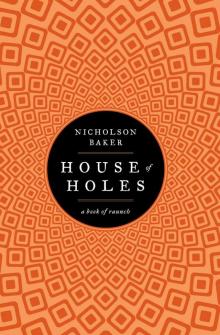 House of Holes
House of Holes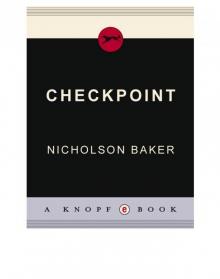 Checkpoint
Checkpoint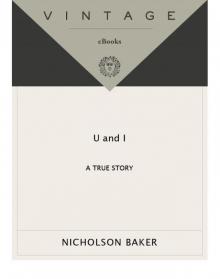 U and I
U and I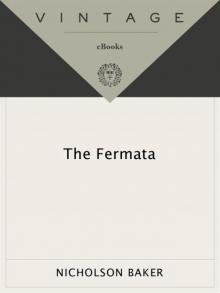 The Fermata
The Fermata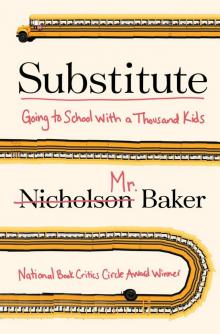 Substitute
Substitute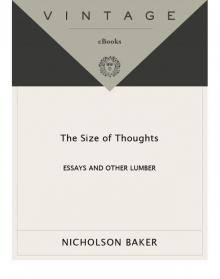 The Size of Thoughts
The Size of Thoughts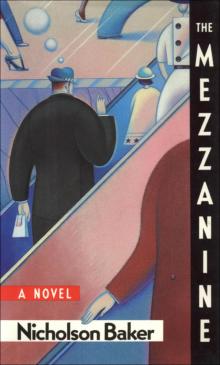 Mezzanine
Mezzanine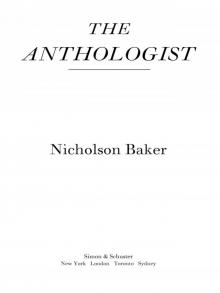 The Anthologist
The Anthologist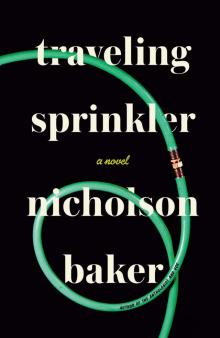 Traveling Sprinkler
Traveling Sprinkler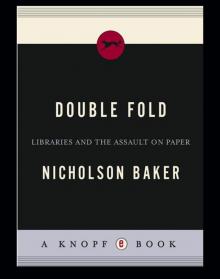 Double Fold
Double Fold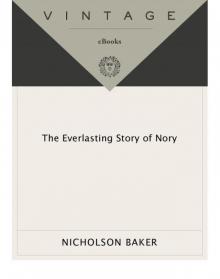 The Everlasting Story of Nory
The Everlasting Story of Nory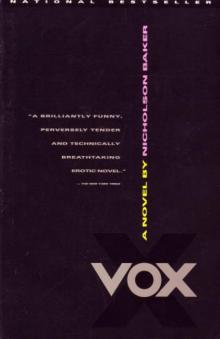 Vox
Vox Vintage Baker
Vintage Baker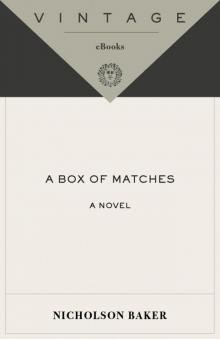 A Box of Matches
A Box of Matches